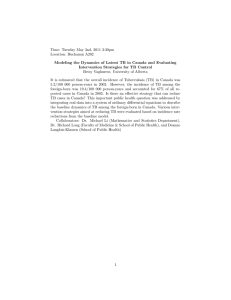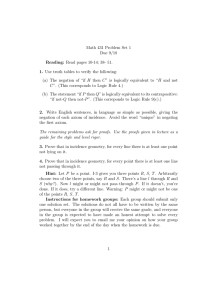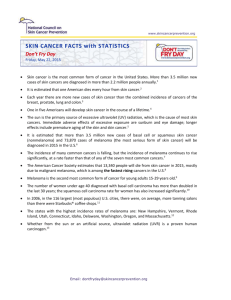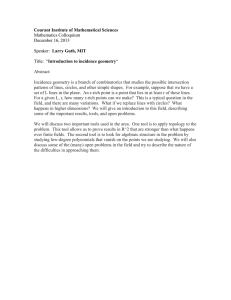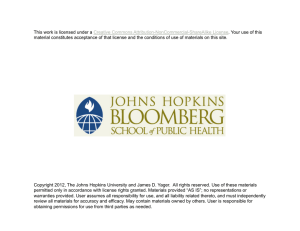Document 14092865
advertisement
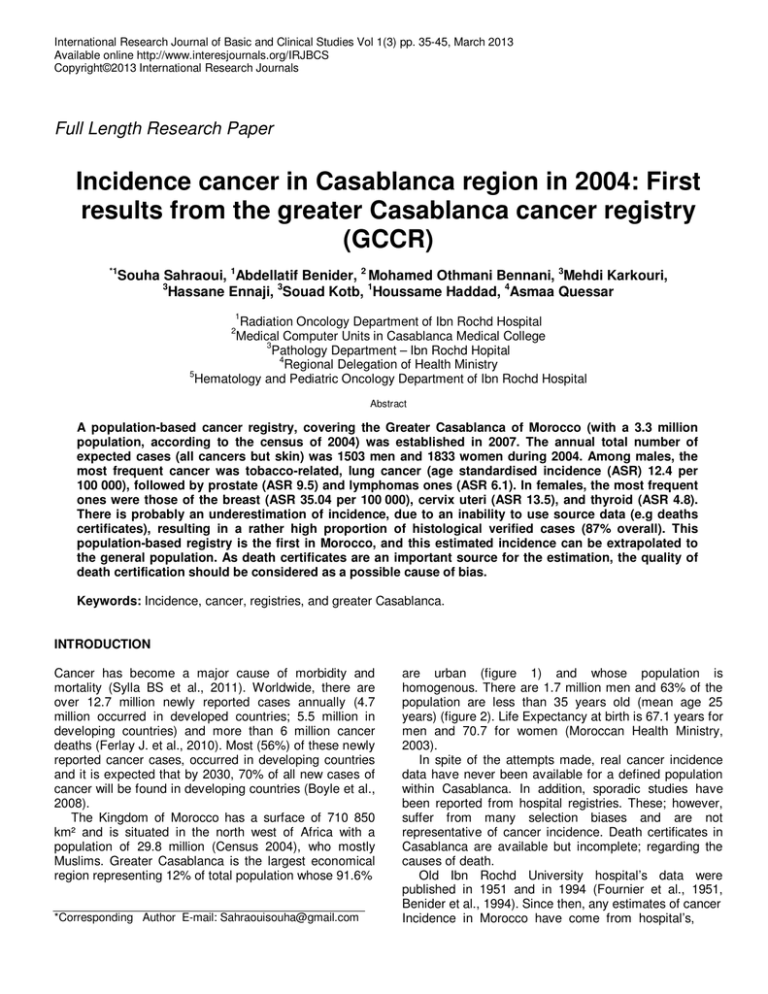
International Research Journal of Basic and Clinical Studies Vol 1(3) pp. 35-45, March 2013 Available online http://www.interesjournals.org/IRJBCS Copyright©2013 International Research Journals Full Length Research Paper Incidence cancer in Casablanca region in 2004: First results from the greater Casablanca cancer registry (GCCR) *1 Souha Sahraoui, 1Abdellatif Benider, 2 Mohamed Othmani Bennani, 3Mehdi Karkouri, 3 Hassane Ennaji, 3Souad Kotb, 1Houssame Haddad, 4Asmaa Quessar 1 Radiation Oncology Department of Ibn Rochd Hospital Medical Computer Units in Casablanca Medical College 3 Pathology Department – Ibn Rochd Hopital 4 Regional Delegation of Health Ministry 5 Hematology and Pediatric Oncology Department of Ibn Rochd Hospital 2 Abstract A population-based cancer registry, covering the Greater Casablanca of Morocco (with a 3.3 million population, according to the census of 2004) was established in 2007. The annual total number of expected cases (all cancers but skin) was 1503 men and 1833 women during 2004. Among males, the most frequent cancer was tobacco-related, lung cancer (age standardised incidence (ASR) 12.4 per 100 000), followed by prostate (ASR 9.5) and lymphomas ones (ASR 6.1). In females, the most frequent ones were those of the breast (ASR 35.04 per 100 000), cervix uteri (ASR 13.5), and thyroid (ASR 4.8). There is probably an underestimation of incidence, due to an inability to use source data (e.g deaths certificates), resulting in a rather high proportion of histological verified cases (87% overall). This population-based registry is the first in Morocco, and this estimated incidence can be extrapolated to the general population. As death certificates are an important source for the estimation, the quality of death certification should be considered as a possible cause of bias. Keywords: Incidence, cancer, registries, and greater Casablanca. INTRODUCTION Cancer has become a major cause of morbidity and mortality (Sylla BS et al., 2011). Worldwide, there are over 12.7 million newly reported cases annually (4.7 million occurred in developed countries; 5.5 million in developing countries) and more than 6 million cancer deaths (Ferlay J. et al., 2010). Most (56%) of these newly reported cancer cases, occurred in developing countries and it is expected that by 2030, 70% of all new cases of cancer will be found in developing countries (Boyle et al., 2008). The Kingdom of Morocco has a surface of 710 850 km² and is situated in the north west of Africa with a population of 29.8 million (Census 2004), who mostly Muslims. Greater Casablanca is the largest economical region representing 12% of total population whose 91.6% *Corresponding Author E-mail: Sahraouisouha@gmail.com are urban (figure 1) and whose population is homogenous. There are 1.7 million men and 63% of the population are less than 35 years old (mean age 25 years) (figure 2). Life Expectancy at birth is 67.1 years for men and 70.7 for women (Moroccan Health Ministry, 2003). In spite of the attempts made, real cancer incidence data have never been available for a defined population within Casablanca. In addition, sporadic studies have been reported from hospital registries. These; however, suffer from many selection biases and are not representative of cancer incidence. Death certificates in Casablanca are available but incomplete; regarding the causes of death. Old Ibn Rochd University hospital’s data were published in 1951 and in 1994 (Fournier et al., 1951, Benider et al., 1994). Since then, any estimates of cancer Incidence in Morocco have come from hospital’s, 36 Int. Res. J. Basic Clin. Stud. Mohammadia Anfa Aïn Sebaa HM Bernoussi Fida Hay Ben M’sik My Rchid Hassani Médiouna Nouaceur Figure 1. Greater Casablanca, Morocco Figure 2. Population distribution of Greater Casablanca by age and sex (census 2004) Sahraoui et al. 37 registries. The main objective of population-based Cancer Registries is to provide demographic data and identify risk factors, essential for the assessment of the magnitude of cancer problem as well for monitoring the progress of the National Cancer Control Plan (NCCP 2002). Data on cancer incidence are traditionally obtained from population-based registries (Jansen et al., 1991). Ascertaining and updating the main cancer burden indicators nationally is essential for monitoring the spreading of the disease (cancer), setting the priorities in health programmes, defining research areas and developing cancer plans (Boyle et al. ,2008). Southern European countries, such as Spain, France, and Italy systematic data for the entire population are confined to mortality but the other indicators, such as incidence and survival, are provided by population-based cancer registries, which cover, only a fraction of the country (Parkin et al., 2006). Greater Casablanca Cancer Registry (GCCR) is the first population-based cancer registry in Morocco. It was founded in March in 2003 by a team composed of medical college professors working in different fields. It’s supported by the Ministry of Health, and; it’s now working as an independent department and is considered as an International Agency Cancer Registries (IACR) member. The article reports the first cancer rates estimated from population based data collected during 2004 and the comparison to cancer incidence regionally and worldwide. PATIENTS AND METHODS We analysed data from Greater Casablanca population and the denominator population data were drawn from data reported by the Moroccan High Commission for planning (National Census 2004). Data are actively collected from different hospitals (public and private). Cancer related data are extracted from patient’s medical records based on clinical and histopathological diagnosis of cancer using special form designed for this purpose. The tumours are coded for topography and morphology using the International Classification of Diseases: Oncology, second edition (ICD-O-3) of the World Health Organization (WHO) (WHO 2000), according to the recommendation of the European Network of Cancer Registries (ENCR). Incidence data were extracted basing on sex from common cancer sites. The data included patient’s numbers, name, sex, date of birth, address, date of diagnosis, most valid basis of diagnosis, topography, tumour morphology and if possible the clinical stage and the follow up. After analysis, the data were partitioned into eight age groups: 0-14, 15-24, 25-34, 35-44, 45-54, 55-64, 65-74, 75 years and over. It was clear that children aged less than one year were recorded as being 12 months old. All Tumours, the central nervous system, bladders’ tumours and only the invasive cases were included. Therefore, the death certificates were not used as a source. The collected data were computerised using version 6 of the EPI-INFO. All essential data were revised for monitoring any duplication or incompleteness by the Medical computer unit in Casablanca Medical College. Validation checks of the entered data were carried out by the computer system on each data item to ensure that all were valid codes and the confidentiality of the received data was one of the important tasks of the working group. The following calculation methods for the registration work were: percentage, age specific rates and the agestandardized incidence rate (ASR). The person-years of population at risk by sex and 10age groups were estimated based on population according to the 2004 census. RESULTS The total number of cancer cases recorded during 2004 (1 January to 31 December 2004) was 3336 (males: 1503; Female 1833) and male to female ratio was 0.83:1. Tables 1 and 2 show the principal cancer sites, the number of cases within 10-year age groups as well as age-standardised incidence rate (ASR) for males and females respectively. The proportion of the microscopical verification was 87% ranged 98% for colorectal cancer and 37% for pancreas (table 3). The combined age standardized incidence rate for all cancers were 101.5 per 100 000, 100.3 per 100 000 (ASR) for males and 104.2 per 100 000 for females (ASR). In males, lung cancer was by far common cancer (23.7%; ASR 12.4), followed by prostate (8.2%; ASR 9.5), lymphomas (6.1%; ASR 6.1) and larynx (5.6%; ASR 1). Another smoking related cancer; bladder was higher in men than in women. In females, breast cancer was the most frequent malignancy (36.1% of cancer; ASR 35), followed by cervix uteri cancer (12.8%; ASR 13.5), thyroid (5.3%; ASR 4.8) and ovary cancer (4.9%; ASR 5.1). The tables 3 and 4 also show the principal cancer sites and ASR for males and females respectively. According to the international Classification for childhood Cancer (0-14 years of age) the incidence ASR was 1.34/100 000 (table 4). Only the percentage was calculated due to the small sample of cases in childhood. The most common cancers in this group were haematology malignancies (19.8% of cases) followed by brain and spinal neoplasm’s (17.1% of cases), and bone (12.3 % of cases). 38 Int. Res. J. Basic Clin. Stud. Table 1. Number and incidence rates by site and age groups in Greater Casablanca during 2004 (males) using the world standard population. Site Numbers of cases by age groups (years) NA Oral cavity Nasopharynx Other pharynx Oesophagus Stomach Colon/rectum Liver Gall bladder Pancreas Larynx Bronchus, lung Bone Skin Connective tissue Prostate Testis Bladder Kidney, ect. Brain, nervous system Thyroid Non-Hodgkin’s lymphoma Hodgkin’s disease Leukaemia Primitive unknown Other Haematology malignancies Other sites All sites 3 2 0 0 2 4 3 0 2 5 2 0 3 1 3 0 1 0 0 1 1 0 1 1 0 3 39 014 0 1 0 0 0 0 2 0 0 0 0 7 1 3 0 3 0 2 7 0 0 3 7 0 1 12 49 1524 0 6 0 2 1 2 1 0 0 1 0 7 0 3 0 2 0 0 2 1 3 4 9 1 1 0 46 2534 1 1 0 1 0 3 1 0 0 0 6 4 0 1 0 3 4 1 1 1 9 7 7 3 4 2 62 3544 5 11 0 3 11 21 0 2 3 2 17 1 1 3 0 2 2 0 9 3 8 9 4 6 2 7 130 4554 11 24 1 1 11 23 0 2 11 28 97 2 11 4 7 0 14 5 10 2 21 5 2 18 9 17 338 DISCUSSION Cancer is the second leading cause of death in developed countries and is among the third leading causes of death for adults in developing countries. A total of 12.6% of all deaths are caused by cancer, more than the number caused by HIV/AIDS, tuberculosis and malaria put together (WHO, 2003). Cancer registry is considered the corner stone for the documentation of basic data about cancer patients and an entry into a computerized register. This is considered as an initial step in the beginning of the establishment of the epidemiology of cancer and at the same time attempting to ensure continuity of care for the patient (Parkin et al., 2006). Developing a National Cancer Control Program (NCCP) is to assess the magnitude of the cancer problem. The cancer demographic data, risk factors data, data on the other diseases and capacity assessment are 5564 4 8 1 0 24 28 3 0 9 23 101 1 9 3 28 0 24 2 10 4 19 1 3 22 12 9 350 6574 6 8 1 5 8 15 5 1 6 16 84 1 5 2 47 0 18 0 2 1 19 1 5 13 6 10 285 >74 Total Relative frequency (%) 3 4 0 3 5 9 0 2 1 9 51 0 10 1 39 0 21 2 1 3 12 2 3 5 4 7 199 35 65 3 15 62 105 15 7 32 84 358 23 40 21 124 10 84 12 42 16 92 32 41 69 39 67 1503 1.97 4.42 0.17 1.00 4.13 5.89 1.00 0.47 2.13 5.59 23.75 1.53 2.66 1.40 8.25 0.67 5.59 0.80 2.79 1.06 6.12 2.13 2.73 4.59 2.02 9.16 100 Annual incidence rate (per 100 000) Crude Standardized 2.34 4.32 0.20 0.84 3.48 6.99 0.84 0.39 1.80 4.71 20.03 1.29 2.24 1.18 6.96 0.56 4.71 0.67 2.36 0.90 5.16 1.80 2.30 3.87 2.02 4.06 84 2.00 3.74 0.20 1.03 4.13 6.69 0.93 0.43 2.11 5.60 25.53 1.25 2.63 1.26 9.58 0.55 5.81 0.74 2.55 0.96 6.11 1.66 2.43 4.77 2.37 7.61 100.3 needed for the initial analysis of the national strategies against cancer. A cost-effective NCCP can be organized independently or a cancer surveillance program can be built around a stable population-based population cancer registry (NCCP, 2002). But it requires an effective surveillance and a monitoring system, providing accurate data on cancer incidence and out come from populationbased cancers registries. Cancer is a complex health problem; it requires multidisciplinary approaches: promotion to prevention, screening to diagnosis, treatment; rehabilitation and palliative care. Improving national control plans, mass screening programmes and population-based cancer registries, constitutes a primordial role (Gouveia et al., 2008). The European Network of cancer registries developed recommendations for the standard data set to be routinely recorded for all cancer patients (Sankita et al., 2008). Sahraoui et al. 39 Table 2: Number and incidence rates by site and age groups in Greater Casablanca during 2004 (Females) using the world standard population. Site Oral cavity Nasopharynx Other pharynx Oesophagus Stomach Colon/rectum Liver Gall bladder Pancreas Larynx Bronchus, lung Bone Connective tissue Skin Bladder Kidney, ect. Breast Vulvar Vagina Cervix uteri Corpus uteri Ovary Brain, nervous system Thyroid Non-Hodgkin’s lymphoma Hodgkin’s disease Leukaemia Primitive unknown Other, sites All sites Numbers of cases by age groups (years) N A 1 1 0 1 0 3 7 0 0 1 0 0 0 5 0 0 26 0 0 10 4 6 0 7 0 0 0 4 1 70 014 0 2 0 0 0 0 1 0 0 0 0 6 2 6 0 4 0 0 0 0 0 2 11 1 3 4 3 1 7 53 1524 1 4 0 0 1 1 0 0 0 0 0 3 1 0 0 0 12 0 0 0 1 4 2 9 4 9 2 0 0 57 2534 2 2 0 1 7 4 0 0 0 0 1 1 0 1 0 0 39 0 1 4 2 7 2 17 9 8 1 7 3 119 3544 1 3 0 4 3 9 0 0 3 2 2 0 2 3 1 0 206 2 1 42 3 13 9 20 3 1 1 8 5 341 4554 4 3 1 4 4 24 1 6 3 1 11 2 2 2 1 2 215 2 1 91 12 21 6 22 14 2 5 8 14 484 The descriptive data presented in this report are the first to be submitted on cancer incidence in Morocco for international publication. According to the IARC recommendations, the following information is considered basic in a populationbased cancer registry: date of diagnosis; basis of diagnosis; site of primary tumour; morphology; behaviour of tumour; source of information; place of residence; ethnic group; and personal information sufficient to ensure the recognition of an individual when the same person is reported more than once to the registry (Sankita et al., 2003). All items were registered in the 5564 12 1 0 5 13 26 1 5 6 2 5 0 3 10 3 3 111 3 1 49 12 17 3 14 17 0 3 15 19 359 6574 6 0 0 3 17 22 4 8 4 2 11 0 1 10 3 3 36 4 2 26 13 15 1 6 17 4 6 6 13 239 Relative frequency >7 4 2 2 0 2 1 5 0 3 3 0 3 1 0 6 2 1 17 2 0 13 2 6 0 1 6 2 1 9 9 97 Total 29 18 1 20 46 94 7 22 19 8 33 13 11 43 10 13 662 13 6 235 49 91 34 97 73 30 22 58 76 1833 (%) 1.57 0.98 0.10 1.09 2.51 5.13 0.38 1.20 1.04 0.44 1.80 0.71 0.60 2.35 0.60 0.71 36.12 0.71 0.33 12.82 2.67 4.96 1.85 5.29 3.89 1.64 1.20 3.16 7.31 100 Annual incidence rate (per 100 000) Crude Standardized 1.57 0.98 0.10 1.09 2.51 5.13 0.38 1.20 1.04 0.44 1.80 0.71 0.60 2.35 0.60 0.71 36.14 0.71 0.33 12.83 2.67 4.97 1.86 5.30 3.99 1.64 1.20 3.17 7.33 100 1.88 0.88 0.06 1.71 3.03 5.83 0.48 1.46 1.21 0.43 2.13 0.76 0.96 2.49 0.69 0.97 35.04 0.83 0.34 13.46 2.82 5.12 2.03 4.78 4.62 1.56 1.38 3.22 7.25 104.2 GCCR, except the ethnicity. One of the most important indicator of the completeness of cancer data is the reasonable (not very high) proportions of microscopical verification (MV) cases (Parkin et al., 2005. The percentage of the MV of all sites was 87% which is not very high but similar to the European countries observed of rates 88% (Ferlay et al., 2006). This is consistent with other registries such as 94.4% for SEER 14 registries, 97.1% for Germany Saarland and 86.0% for Spain Granada (Curado et al., 2007). This proportion may represent an under-registration of 40 Int. Res. J. Basic Clin. Stud. Table 3. Percentage of cases with pathological confirmation by site and sex Localization All cases except skin Nasopharynx Oesophagus Stomach Colon Rectum Liver Balladry and balladry cysts Pancreas Larynx Lung Breast Cervix uteri Corpus uteri Ovary Prostate Bladder Kidney Central nervous system Thyroid Unknown primitive Male 84 85 100 92 89 96 87 71 41 81 74 87 92 92 90 88 71 Female 89 78 85 91 98 98 57 86 37 100 78 90 90 82 77 90 100 85 98 66 Total 87 83 91 92 93 97 77 86 39 83 76 90 90 82 77 87 91 96 88 96 69 Table 4. Percentage of cases in childhood: (less than 15 years old) Haematology malignancies Brain and spinal neoplasm’s Bone Adrenal glands Eyes Skin Kidney Soft Tissues Testis Liver Nasopharynx Ovary Thyroid Unknown primitive Total clinically-diagnosed cases. Patients with advanced malignancies (clinically or radiologically diagnosed) and who are less likely to be subject to intense diagnostic and therapeutic procedures. In the future, the data analysis will use CANREG-4 Number 21 18 13 12 11 7 6 5 3 3 3 2 1 1 106 % 19.8 17.1 12.3 11.3 10.4 07.0 05.7 04.7 02.8 02.8 02.8 01.9 00.9 00.9 100 software for data management further enhances the validity. Incidence rates in females were much higher than in males. In part, this is a consequence of the much higher incidence rates for breast and cervix uteri cancers. In Sahraoui et al. 41 Table 5. The first ten cancers in Greater Casablanca compared to estimated cancer incidence for Morocco by GLOBOCAN 2002 (Parkin, 2005; Jemal, 2008) Males Sites Lung Bladder Prostate Stomach Colon+Rectum Larynx NHL Nasopharynx Leukeamia Oral cavity All sites GCCR 2004 12.4 5.8 9.5 4.1 6.7 5.6 6.1 3.7 2.4 2.0 101.5 GLOBOCCAN Females Sites 2002 20.1 9.7 6.4 5.8 5.8 5.5 5.3 4.8 3.6 2.6 95.7 Breast Cervix uteri Colon + Rectum NHL Ovary + etc Stomach Thyroid Leukeamia Nasopharynx Lung All sites 2008 27.8 5.4 12.0 21.1 12.3 3.5 4.2 2.1 4.5 4.6 160.3 addition, the incidence rates in females were under estimated due to the absence of breast and cervix uteri national screening programs. So, breast cancer was the most common cancer in women that could increase with changes in diet, body weight, and fertility of the population. In males the incidence rates was lower than in females and under diagnosed cases with tobacco-related cancers and prostate cancer and the absence of national screening program. Bladder cancers were most frequent in males and the thyroid and gallbladder cancers were of higher incidence in females. This difference was less among females and males for stomach, colon, leukaemia and non Hodgkin lymphomas. Internationally, Parkin et al., (2005) estimated that there were 10.9 million new cases, 6.7 million deaths, and 24.6 million persons living with cancer (within 5 years of diagnosis) in the year 2002. There are some differences in the profile of cancers worldwide depending on whether incidence or mortality is the focus of interest. Lung cancer is the main cancer in the world today, whether considered in terms of numbers of cases (1.35 million) or deaths (1.18 million), because of the high case fatality (ratio of mortality to incidence, 0.87). Breast cancer, the second most common cancer overall (1.15 million new cases), ranks less highly (fifth) as a cause of death because of the relatively favourable prognosis (mortality to incidence ratio, 0.35), and cancers of the stomach (934,000 cases, 700,000 deaths), liver (626,000 cases, 598,000 deaths), and colon and rectum (1.02 million cases, 529,000 deaths) rank higher. In men, although lung cancer is the most common cancer worldwide (in developing and developed countries), it is second behind prostate cancers in developed countries. In women, breast cancer is the most common site GCCR 2004 35.04 13.4 5.8 4.6 5.1 3.0 4.8 1.3 0.8 2.1 104.2 GLOBOCCAN 2002 22.5 13.2 5.5 3.5 3.4 3.1 2.9 2.5 2.1 2.0 86.8 2008 27.3 17.8 9.4 2.8 5.0 10 3.4 3.6 1.0 11.1 138.0 worldwide and cervix cancer remains second in developing countries, but seventh in the developed world, with fewer cases (83,000) than for corpus uteri cancer (136,000) and ovary (97,000) (Parkin et al. ,2005). There is a large variation of the incidence of breast cancer in the world. The factors that contribute to the international variation in incidence rates largely stem from differences in reproductive and hormonal factors and the availability of early detection services (Jemal et al., (2010) Mackay et al., 2006). The breast cancer incidence increases in the world probably come from changes in reproductive factors with increased use of postmenopausal hormone therapy (Althuis et al., 2005, Sankaranarayann et al., 2010). While incidence rates for all cancer combined in economically developed countries are nearly twice as high as in economically developing countries in both males and females, mortality rates for all cancer combined in developed countries are only 21% higher in males and only 2% higher in females. In general, incidence rates are high in western and northern Europe, Australia/new Zeeland, and the Caribbean, and North Africa and low in sub-Saharian Africa and in Asia (Jemal, Bray 2011). It’s clearly that the ASR in Casablanca remains less than in the developed countries (tables 5, 6) due to less registration and the absence of national early diagnosis and screening. In males the most common cancers are prostate, lung and colorectal ones. In the absence of national incidence information for Morocco, the International Agency Registries Cancers (IARC) developed an estimation methods based on national mortality and on local incidence and mortality data; this method is frequently used to obtain information nationwide (Parkin et al., 1999, 2005, Jensen et al., 1990, Black et al., 1997). GLOBOCAN (Parkin et al., 2005) 42 Int. Res. J. Basic Clin. Stud. Table 6. Age standardized incidence rates (world standard) in Casablanca, and comparison with registries in developed countries. (Males) Morocco, Casablanca (2004) USA SEER (1975-2002) Canada Germany, Saarland (1998-2002) Lung Bladder Prostate Stomach Larynx *NH L **NP C Leukaemi a 4.1 Colon + Rectum 6.7 12.4 5.8 9.5 6 6.1 3.7 2.4 77.8 36 173.8 12.3 62.3 9.4 23.1 1 16.5 75 59.6 24 12.8 124 65.3 12 13.6 65 50.5 6 5.9 19 10.7 0.8 0.9 14 9.0 *NHL: Non Hodgkin lymphoma, **NPC: Nasopharyngeal carcinoma. USA, SEER (Ries, 2004), Canada (http://www.cancer.ca), Germany:Saarland, (Curado, 2007). Table 7. Age standardized incidence rates (world standard) in Casablanca, and comparison with registries in developed countries. (Females) Morocco, Casablanca (2004) USA SEER (1975-2002) Canada Germany, Saarland (1998-2002) Breast Cervix uteri Thyroid NHL** Stomach Corpus uteri Lung Larynx NPC* 13.5 Colon + Rectum 5.8 35.0 4.8 4.6 3.0 2.8 2.1 0.4 0.8 134.4 8.9 46 11.7 15.8 6.1 23.8 48.9 1.4 0.4 101 8 44 10 14 5 19 44 0.9 0.4 76.6 9.8 31.7 7.9 10.1 6.9 5.3 4.8 17.3 0.4 *NHL: Non Hodgkin lymphoma, **NPC: Nasopharyngeal carcinoma. USA, SEER (Ries, 2004), Canada (http://www.cancer.ca), Germany:Saarland, (Curado, 2007). provide an estimation of age-standardised incidence rate (ASR) at 95.7 for males and 86.8 in Morocco. These values are lower than those in GCCR. With regard to the ten first localisations of cancer, there is noticeable difference between our findings and the estimated cancer incidence for Morocco by GLOBOCAN 2002 and GLOBOCAN 2008 (Jemal et al., 2011) with underestimation for ASR in males and females (all sites except melanoma of skin) (Ferlay et al., 2004). For males, the incidence estimation was higher than the results of GCCR for lung, stomach and lymphomas. For lung and stomach, this may be due to under diagnosed cases. For females, the GLOBOCAN 2002 estimation is 22.5/100 000 inhabitants for breast, 27.3/100 000 for GLOBOCAN 2008 versus 35.0/100 000 residents for GCCR, this incidence could be increased with screening and early diagnosis. For the other sites, the estimation was similar for cervix uteri and colorectal in 2002 and higher in 2008, lymphoma. The ASR for thyroid cancer was higher with 4.7 recorded in the GCCR than respectively 2.9 for GLOBOCAN 2002 and 3.4 for 2008 estimation (table 7). The GLOBOCAN database uses a large amount of data, derived from cancer registries from different national populations or subsamples from selected regions. Therefore, the difference is perhaps due to a hypothetical incidence for all cancers calculated from other registries in the region and the relative frequency of cancers in the hospital with imperfect data collection. Further investigation in other cities like Rabat, Fés and Agadir are necessary to obtain a real map of the cancer incidence in Morocco. In the tables 8, 9 the ASRs for the major cancer sites in Greater Casablanca are summarised and compared with the results from cancer registries elsewhere in the Mediterranean and Maghreban regions Sahraoui et al. 43 Table 8. Age standardized incidence rates (world standard) in Casablanca, and comparison with Maghreban and Mediterranean registries. (Males) Morocco, Casablanca 2004 Algeria 1993-1997 Tunisia Egypt, Gharbiah (1999-2002) Spain, Granada (1998-2002) Italy, Ragusa (1998-2002) Malta (1998-2002) Lung Prostate NHL Bladder Larynx Stomach NPC Leukaemia 9.58 Colon + Rectum 6.69 25.53 6.11 5.81 5.60 4.13 3.74 2.43 17.2 5.4 7.1 3.6 10.8 4.3 5.6 2.7 29.4 8.3 7.5 5.3 13.4 6.8 6.6 3.5 14.0 8.5 6.3 16.9 27.9 4.2 3.3 60.3 22.8 15.4 6.5 19.6 9.4 16.3 45.1 28.1 30.6 7.9 33.1 4.7 10.8 38.8 35.1 27.0 10.5 26.8 5.2 10.9 - 6.0 - 9.5 - 10.3 - Egypt, Gharbiah (1999-2002), Spain, Granada (1998-2002), Italy, Ragusa (1998-2002), Malta (1998-2002) (Curado 2007). Table 9. Age standardized incidence rates (world standard) in Casablanca, and comparison with Maghreban and Mediterranean registries. (Females) Morocco, Casablanca 2004 Algeria 1993-1997 Tunisia Egypt, Gharbiah (1999-2002) Spain, Granada (1998-2002) Italy, Ragusa (1998-2002) Malta (1998-2002) Breast Cervi x uteri Ovary Thyroid NHL Stomach Corus uteri Lung NPC 13.4 Colon + Rectum 5.8 35.0 5.1 4.7 4.6 3.0 2.8 2.1 0.8 21.3 12.5 6.1 4.2 4.2 2.1 3.7 2.2 1.9 1.3 25.6 42.5 6.1 2.1 7.0 4.3 5.1 2.9 2.9 3.5 9.9 3.7 2 2.6 1.9 3.6 1.6 - 55.9 6 19.3 8.3 7.4 6 5.6 13.6 3.3 - 61.6 5.7 22.3 9.5 10 7 5.1 12.3 5.4 - 67.7 3.9 22.3 10.8 9.4 7.6 4.6 16.5 6.1 - Egypt, Gharbiah (1999-2002), Spain, Granada (1998-2002), Italy, Ragusa (1998-2002), Malta (1998-2002) (Curado 2007). (Algeria and Tunisia). In the 3 countries of the Maghreb, the first cancer in males is lung, the second was colorectal in Casablanca ant Algeria, but in Tunisia the second site is the prostate cancer. For female, breast cancer in the most frequent site. When the cervix uteri cancer is the second cancer in Algeria and Casablanca, in Tunisia it stands as the third cancer. There is a good striking feature of the cancer profile, in males with high incidence of tobacco-related cancers lung and larynx except bladder. Tobacco smoking may also be responsible for the relatively high incidence of 44 Int. Res. J. Basic Clin. Stud. those two cancers. Environmental factors play an important role in oncogenesis. These are the factors that can be readily controlled than the genetic and racial ones. “In countries where awareness of cancer is low and access to health care is limited, only a small proportion of actual cases are known to the health services” (WHO 2008). The tobacco-associated cancers are responsible for 39.1 % of the tumours in males and 3.6 % in females. Breast cancer, the commonest female cancer in the world, is higher in Morocco, and cervical cancer remains high. With the implementation of early detection through screening, these may be higher. In males, primary prevention against working could reduce 39.1% of the cancer cases. This can be achieved by National education program, especially for children (school), adolescents and healthcare providers and by mass education. In both genders, the control of half the number of cancers due to diet factors (breast, colon, rectum, and gastric cancers), viral infection (cervix uteri with human papilloma virus, liver cancer with hepatitis virus B, gastric cancer with helicobacter Pylori), and solar UV exposition can be prevented through primary prevention. Early detection of accessible cancers like cervical, breast and oral ones will increase the proportion of localised stages at diagnosis with good survival but, firstly cancer control activities should focus on education like self-examination of the breast, physician’s breast examination. For paediatric cancer the comparison will be difficult because of the absence of the use of the International classification of childhood cancer (Karmarova et al., 1996). CONCLUSION The based-population GCCR revealed an objective approach of the incidence of cancer in Casablanca, despite some probable under ascertainment of histological diagnoses cases, and under diagnosed cases due to the absence of a screening (prostate, breast, or cervix uteri cancers). For males, tobacco control measures in particular are important, in view of the two first cancers in males related to tobacco. For females, breast cancer accounted for more than the third of all new cases and appropriate methods of ensuring early detection and effective treatment are important for its control. Now, we are collecting cases that occurred during 2005, 2006 and 2007 and the results will be published to explore the evolution since 2004. Conflict of interest statement None declared. ACKNOWLEDGEMENTS On behalf of the GCCR committee, all staff would like to express their gratitude to all those who contributed to this work. We are also grateful to Lalla Salma Association against Cancer for their support and also to all the departments of the Ministry of Public Health. REFERENCES Althuis MD, Dozier JD, Anderson WF, Devesa SS, Brinton LA (2005). Global trends in breast cancer incidence and mortality 1973-1997. Int. J. Epidemiol. 34:405-12. Benider A, Samlali R, Acharki A, Sahraoui S, Kahlain A (1994). Approche épidémiologique des cancers au Maroc. Médical. 277:32-5. Black RJ, Bray F, Ferlay J, Parkin DM (1997). Cancer incidence and mortality in the European Union: Cancer registry data and estimates of national incidence for 1990. Eur. J. Cancer, 33(7):1075-1077. Boyle P, Levin B (eds) (2008): World Cancer Report 2008. Lyon, France: IARC 2008. Curado MP, Edwards B, Shin HR (2007). Cancer incidence in five continents, (9): IARC Scientifique publication. N° 160, Lyon, IARC. Ferlay J, Autier P, Boniol M, Heanue M, Colombet M, Boyle P (2007). Estimates of the cancer incidence and mortality in Europe in 2006. Ann Oncol, 18(3):581–92. Ferlay J, Bray B, Pisani P, Parkin DM (2001). Globocan 2000. Cancer incidence and prevalence worldwide. Lyon: IARC. Ferlay J, Bray F, Pisani P, Parkin DM (2004). GLOBOCAN 2002. Cancer Incidence, Mortality and Prevalence Worldwide. IARC Cancer Base 5 (2.0) :Lyon, France: IARCPress. Ferlay J, Shin HR, Bray F, Forman D, Mathers C, Parkin DM (2010). Estimates of worldwide burden of cancer in 2008: GLOBOCAN 2008. Int J Cancer; 127:2893-917. Fournier H, Roos R, Considérations générales sur les statistiques des malades traités au Centre Bergonié pendant l’année 1950. Maroc Médical. 1951:440. Fritz A, Percy C, Jack A, Shanmugaratnam K, Sobin L, Parkin D.M, Whelan S, (2000). International classification of diseases for oncology. CIMO 3 Edition. WHO. Gouveia J, Coleman MP, Haward R et al. ,(2008). Improving cancer control in the European Union. Conclusion from the Lisbon roundtable under the Portuguese EU Presidency, 2007. Europ. J. Of Cancer, 44: 1457-62. High commissariat of Plan Morocco (2004). Population census 2004. (http://www.hcp.ma/ Institut national du cancer du Canada. Statistiques canadiennes sur le cancer (2004). www.cancer.ca International Classification of Diseases for Oncology, 3nd edn. Geneva, WHO 2000. Jemal A, Center MM, Desantis C, Ward EM (2010). Global patterns of cancer incidence and mortality rates and trends. Cancer Epidemiol. Biomarkers Prev; 19: 1893-1907. Jemal A., Bray Global Cancer Statistics CA Cancer J Clin. 2011; 61: 69-90.). Jensen OM, Esteve J, Moller H, Renard H (1990). Cancer in the European community and its member states. Eup J Cancer; 26:11671256. Jensen OM, Parkin DM, Maclennan R, Muir R, Skeet RG (1991). Cancer registration: Principles and methods. IARC Scientific Publications, No:95. Lyon, France: International Agency for Research on Cancer. Kramarova E, Stller CA, Frelay J (1996). International Classification of childhood Cancer. IARC. Technical Report n° 29. Lyon: International Agency for Research on Cancer. Mackay J, Jemal A. Lee NC, Parkin DM (2006). The cancer atlas Atlanta GA: American Cancer Society. Ministry of health Morocco (2003). Health indicators of Morocco 2003.. Rapport Juillet 2003 (http://www.sante.org.ma). Sahraoui et al. 45 National Cancer Control Plan (2002). Policies and Managerial nd Guidelines, 2 edition. WHO Geneva. National Cancer Control Plan (2002). Policies and Managerial nd Guidelines, 2 edition. WHO Geneva. National cancer institute of Canada. http/www.cancer.ca Parkin DM, Bray F, Ferlay J, Pisani P (2005). Global Cancer Statistics, 2002, CA Cancer J. Clin. 55:74-108. Parkin DM. (2006). The evolution of the population-based cancer registry. Nat Rev Cancer, 6: 603-12. Parkin DM., Bray F. Ferlay J., Pisani P. (2005); Global Cancer Statistics, 2002, CA Cancer J Clin.; 55: 74-108. Parkin DM., Pisani P., Ferlay J. (1999); Estmates of the worldwide incidence of twenty-five major cancers in 1990. Int J Cancer. 80:827841. Parkin DM., Whelan SL., Frelay J., Teppo L., Thoma DB. Cancer incidence in five continents. Vol VIII, IARC Scientifique publication N° 155. Registre des cancers Nord Tunisie (2004): 1995-1998. Monograph. Ries LAGEM, Kosary CL, Hankey BF, Miller BA et al eds. SEER Cancer statistics review 1975-2002. National Cancer Institue, Bethesda, M.D. Sankaranarayann R., Brenner H. and al. (2010). Cancer survival in Africa, Asia, Central America: A population-based study. Lancer Oncol. 2010; 11: 165-173. Sankita R, Black R, Coeberg JNW, et al. ,(2003). Evaluation of clinical care by cancer registries. Lyon: IARC Press; Report N°: IARC Technical Publication N° 37. Sylla BS., Wild CP. (2011). A million Africans a year dying from cancer by 2030: what can cabcer research and control offer to the continent? Int J Cancer. World Health Organisation, International Union Against Cancer (2002). Global action against cancer. Geneva: WHO: 1-24. World Health Organisation, International Union Against Cancer (2003). Global action against cancer. Geneva: WHO: 1-24. World Health Organization (2008). The Global Burden of Disease: 2004 Update. Geneva: World Health Organization.

